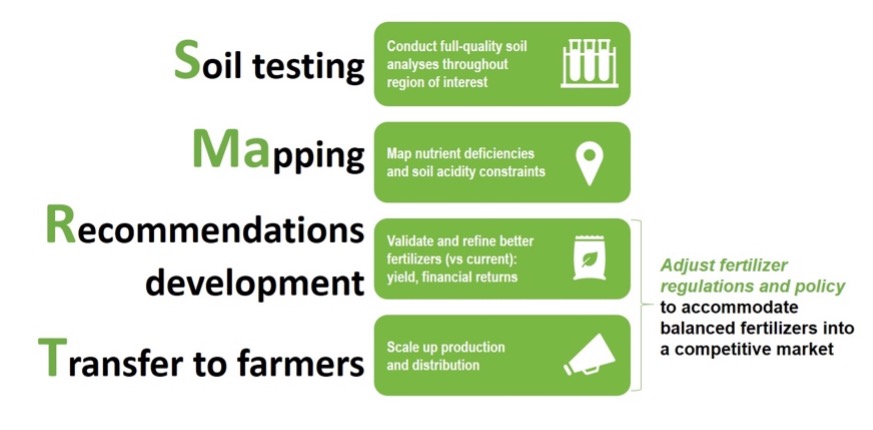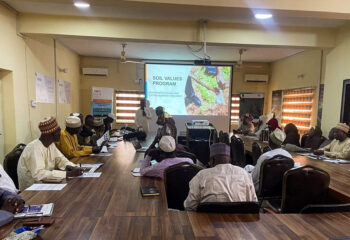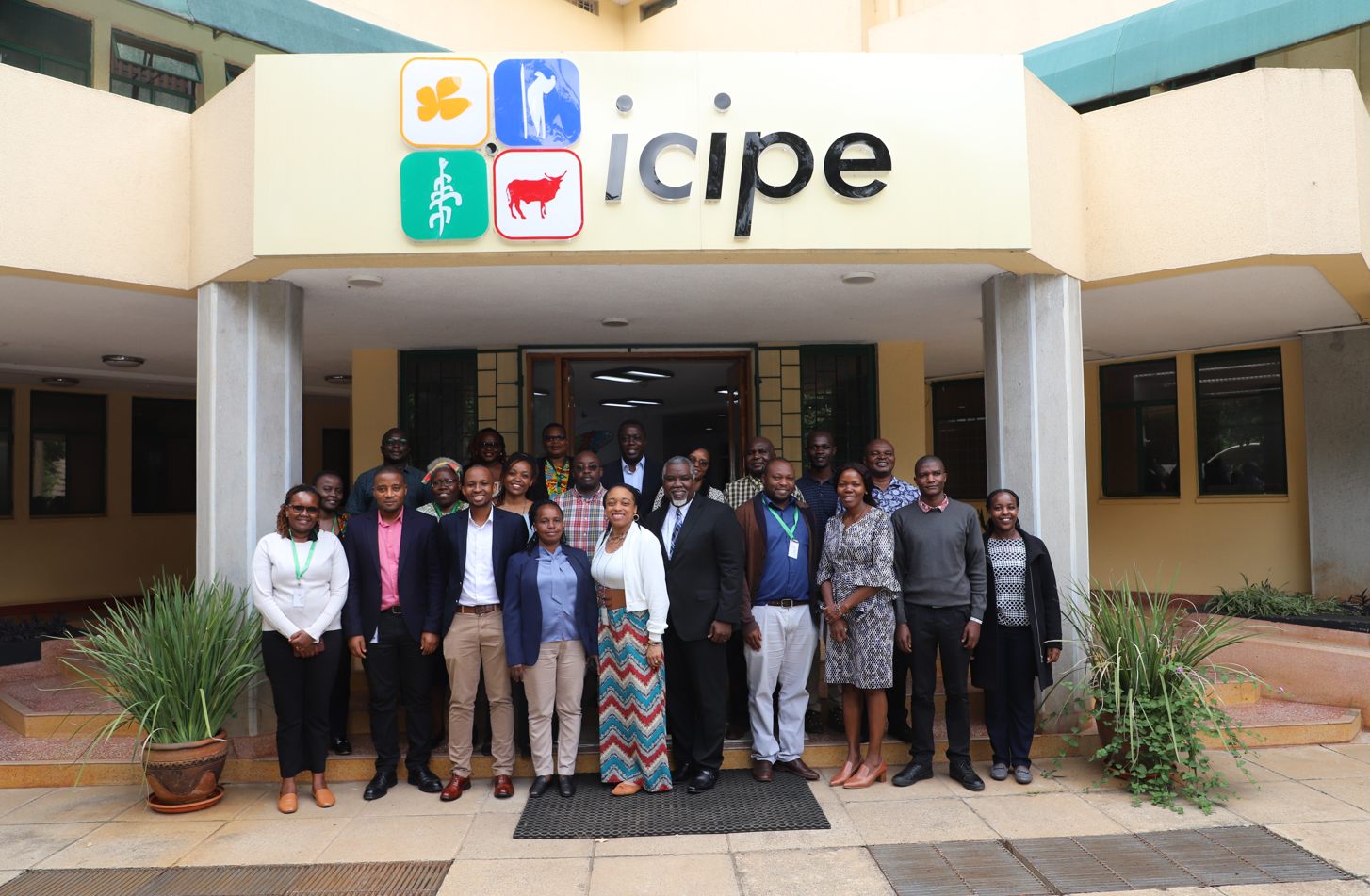
We had the opportunity to sit down with Dr. Upendra Singh and Dr. Prem Bindraban to discuss this year’s topic of sustainability for Global Fertilizer Day. Singh is Deputy Director of IFDC Headquarters Research and specializes in soil fertility and systems modeling. Bindraban leads IFDC’s FERARI program and is a veteran researcher in fertilizers, soil health, planetary boundaries, and global food systems.
What purpose do the 4Rs (right source, right rate, right time, right place) serve?
US. The 4Rs lead to improved nutrient-use efficiency (NUE), increased yield and profitability, and reduced nutrient losses. The latter results in reduced environmental impact. The 4Rs include all nutrient management: right sources include conventional fertilizers as well as organic fertilizers and amendments, or combination of these sources. The remaining three aspects of 4R include nutrient application at the:
- Right time: single versus split application
- Right rate: based on soil test, plant tissue analyses, spectral techniques, and variable rate application sensors.
- Right place: soil-root interaction may involve banding, broadcast, deep placement, etc.
PB. Practicing the 4Rs is the first step to take if the use efficiency of fertilizers is very low. Such was a case I saw in Asia, where vegetable farmers were using more than 1,000 kg of nitrogen per hectare! In cases like this, and in European agriculture decades ago, this 4R approach will simply help reach easy benefits for farm productivity and environmental protection.
But it’s unfair to leave the burden of responsibility solely with the farmers and their practicing of the 4Rs. Evidence shows that fertilizer products, not just practices, must be changed and improved for our planet to stay within safe boundaries. Even with all our efforts to reduce losses with the current products, we will not be able to stay within the “safe operating space of our planetary boundaries”.[1] Therefore, IFDC, our research partners, and the industry are responsible for both continuing to increase manufacturing efficiencies and, more importantly, developing truly novel fertilizer products that feed the plant.
Read more about 4R Nutrient Stewardship.
How does fertilizer contribute to climate change and what is being done to prevent this?
US. Both production and application of fertilizers result in GHG emissions, either as CO2 or N2O. The latter has 300 times greater global warming potential than CO2. 4R nutrient management with improved NUE, which results in reduced fertilizer use and/or reduced losses, can lower fertilizer’s impact on climate change. Fertilizer use within a sustainable intensification framework also has a positive impact on climate change and GHG mitigation. Deforestation and expansion of agriculture into marginal lands lead to climate change. Because fertilizer use supports agricultural intensification, it has saved millions of acres of forest and marginal lands.[2]
PB. More problematic than the contribution that fertilizer production and application make to GHGs are the indirect climate effects that stem from inadequate use of fertilizers. About 80% of food production increase on the African continent has been realized by expansion of agricultural land into pristine natural lands. This conversion of natural land to agriculture leads to the permanent loss of biodiversity and soil organic matter that causes GHG emissions. Agricultural yields remain low, or the rate of increase in yield is extremely low (and often even negative for various crops in some countries), due to insufficient use of fertilizers. This leads to soil nutrient mining, resulting in soil degradation and loss of productivity, further pushing yield trends downward.
So the issue is complex. It seems to be a lose-lose situation, and it will be if we continue on our current trajectory. This is why, for example, IFDC has joined the Coalition of Action 4 Soil Health (CA4SH), which “aims to catalyze and synergize global commitments to and investments in soil health and its caretakers, namely smallholder farmers, by UN Member States, the private sector, civil society and research organizations, and multilateral organizations and foundations.” It’s going to take more than just a single organization or government or farmer. Soil is a common good and a shared resource, and we all have a responsibility to make sure the nutrients we use to increase its health are right – for now and for the future.
What common misconceptions about fertilizer would you like to address?
US. Because of overapplication, fertilizer use has led to air and water pollution and a decline in soil health, e.g., soil acidification, salinity, etc. These impacts are not confined to mineral fertilizers but can also occur from over-application of manures. So, 4R practices also apply to organic farming.
PB. Fertilizers are seen as “chemicals,” and indeed, human-made chemicals do not have the best reputation. The functionality and necessity of fertilizers are confused with other “chemicals,” such as pesticides and herbicides. These are made to kill pests, diseases, and weeds but can be very persistent chemicals. Persistent organic pollutants (POPs) harm the environment and do not degrade. Plastic is another example—just think of the enormous piles of plastic on land and in the ocean. These societal concerns have merit. As researchers, we should not deny the effects of fertilizers on the environment but accept and work through the problem that needs to be solved.
Still, the problem is quite complex. Fertilizers are mostly composed of nutrients that are food for plants to help them grow – and as a result help to feed the world. About half of world’s food is produced through the use of fertilizers.[3] There simply is not enough organic matter (e.g., animal and green manure) that can be incorporated back into the soil to feed the world.[4]
Due to fertilizer overuse, damaging effects can be seen on the environment. Developed nations with surplus food production (and overfed people) dominate the discourse about the use of fertilizers globally—including in Africa, where underuse causes land clearing and deforestation. What we should do is pursue “leapfrog development” for that continent. Skip interim solutions (jumping right over land lines and going straight to cellular networks is a good example of leapfrogging) and develop novel fertilizer products that are more effective and less damaging to the environment (one aim of our FERARI program). We should push for the same with fertilizers. Since we have not yet solved all of the supply problems of our current products, with focused research and development, we may be able to leapfrog past known issues of fertilizer overuse in other countries, skipping straight to novel fertilizer products that do not pose these dangers.
So, we need fertilizers, but we must change the current products, and this requires investments from the industry and research organizations, such as ourselves[5][6].
How can fertilizer be used sustainably – and what is our role?
US. Sustainability depends on judicious and balanced use of fertilizers, according to 4R principles. Integrated Soil Fertility Management (ISFM), which encompasses both conventional fertilizers and organic fertilizers, will improve fertilizer use efficiency and soil health. Locally adapted ISFM improves crop productivity. The proper integration of balanced fertilizers will support increased crop and root biomass, replace nutrients removed from soil in harvested products, sequester carbon, and improve soil health.
PB. The 4Rs are a first step and a good guide for using fertilizer sustainably. In the end, the farmers applying the fertilizers are responsible for the sustainable use of currently available fertilizer products.
The challenge comes when one of the Rs is not as easy to achieve in a particular part of the world. For example, farmers in the U.S. and Europe have access to many different products and technologies that allow for precision use of formulations developed for specifics crops and regions (or even developed an acre at a time!). On the African continent, though, this is not the case. Bulk formulations may be available, but these have not always been developed for specific crops in specific places.
In the short term, IFDC builds smallholder farmer capacity on using the 4Rs and other approaches that take both farmer productivity and environmental protection into account. But we have to look past the short-term or we will never achieve true sustainability.

Thus, IFDC uses the Soil-SMaRT approach to help smallholders achieve balanced crop nutrition, feeding crops with a balanced suite of nutrients that are lacking in the soil. Soil-SMaRT is a step-by-step framework developed by IFDC to deliver balanced fertilizers to farmers.
Putting, novel fertilizers into the hands of farmers is not a task to be accomplished by any one organization or company. It requires cooperation between farmers, governments, the industry, and research organizations. In Ghana, for example, a national multi-stakeholder fertilizer platform has been proposed that follows the Soil-SMaRT approach.
How does fertilizer improve soil health, and how can this contribute to improved food systems?
US. Balanced and judicious use of fertilizers, combined with conservation agriculture (CA) and ISFM, leads to increased productivity and sustainability, with greater recycling of crop and root biomass in soil for improved soil health. A healthy soil holds water and nutrients and improves their use efficiency while increasing plants’ resilience in the face of climate and biotic stresses. Overall, improved soil health leads to better plant health and improved food security, leading to attainment of several SDGs.
PB. We can do a lot more with fertilizers than just increase yield.[7] The impact of fertilizer, depending on its use, can be either positive or negative. Notably, balanced fertilizers can improve the nutritional content of food crops and contribute to fighting human malnutrition. As Upendra said, judicious use of fertilizers increases above- and below-ground biomass, enhancing CO2 capture and maintaining soil organic matter. Increased biomass means greater capture and sequestration of CO2 from the air into the soil. Maintaining soil organic matter results in a significant positive impact on fertilizer use efficiency and on reducing the amount of nitrogen released into the air. Additionally, long-term, appropriate use of fertilizers increases not only soil organic matter accumulation but also soil microbial population and activity. In short, if we use the right fertilizers well, soil health, as well as human health, is improved.[8] And soil health is, literally and figuratively, the foundation for improved global food systems.
Resources
[1] Conijn, J.G., P.S. Bindraban, J.J. Schröder, and R.E.E. Jongschaap. 2018. “Can Our Global Food System Meet Food Demand Within Planetary Boundaries?” Agriculture, Ecosystems and Environment 251:244-256. https://doi.org/10.1016/j.agee.2017.06.001
[2]Angle, J.S., U. Singh, C.O. Dimkpa, D. Hellums, and P.S. Bindraban. 2017. “Role of Fertilisers for Climate-Resilient Agriculture,” Proceedings of the International Fertiliser Society, London, U.K. 802:44.
[3] Smil, V. 2004. Enriching the Earth: Fritz Haber, Carl Bosch, and the Transformation of World Food Production. MIT Press. ISBN: 9780262194495.
[4] Bindraban, P.S., H. van Keulen, and F.P. de Vries. Sustainable World Food Production and Environment Options for Alternative Developments. Wageningen. Delft AB-DLO/WL. Cited in Sustained Risks: A Lasting Phenomenon. Netherlands Scientific Council for Government Policy. Reports to the Government 44.
[5] Bindraban, P.S., C. Dimkpa, L. Nagarajan, A. Roy, and R. Rabbinge. 2015. “Revisiting Fertilisers and Fertilisation Strategies for Improved Nutrient Uptake by Plants,” Biology and Fertility of Soils, 51(8):897-911. http://link.springer.com/article/10.1007/s00374-015-1039-7
[6] Bindraban, P.S., Christian O. Dimkpa, and Renu Pandey. 2020. “Exploring Phosphorus Fertilizers and Fertilization Strategies for Improved Human and Environmental Health,” Biology and Fertility of Soils, 56:299-317 https://doi.org/10.1007/s00374-019-01430-2
[7] Bindraban, Prem S., Christian Dimkpa, Scott Angle, and Rudy Rabbinge. 2018. “Unlocking the multiple public good services from balanced fertilizers,” Food Security, 10:273-285. https://fertiliser-society.org/store/role-of-fertilisers-for-climate-resilient-agriculture/
[8] Angle, J.S., U. Singh, C.O. Dimkpa, D. Hellums, and P.S. Bindraban. 2017. “Role of Fertilisers for Climate-Resilient Agriculture,” Proceedings of the International Fertiliser Society, London, U.K. 802:44.



